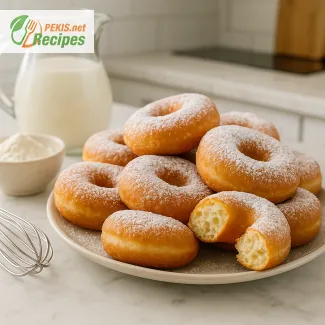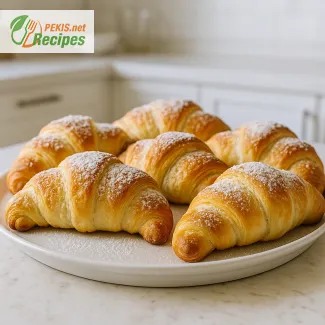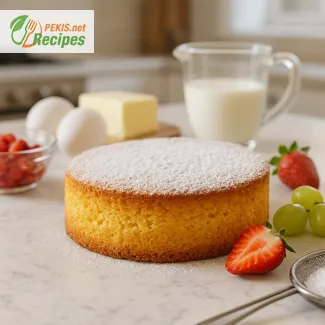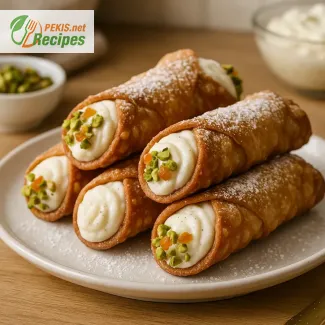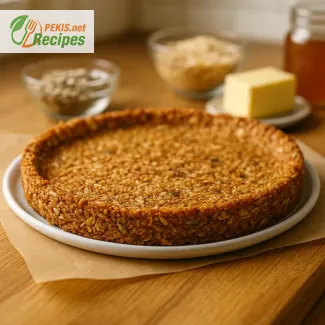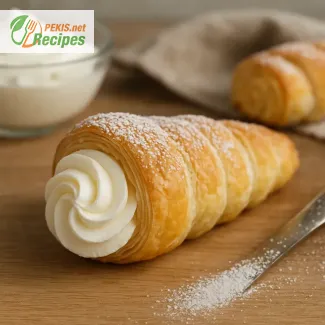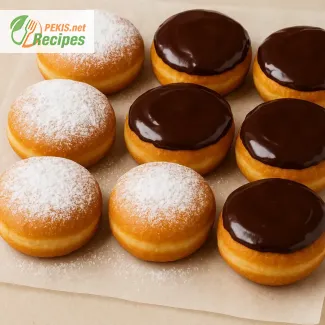
Irresistible Homemade Doughnuts – No Yeast Required
The Perfect Sweet Treat in No Time
There’s something truly special about homemade doughnuts – the crisp exterior, the soft and fluffy inside, and the sheer delight of biting into a fresh, warm pastry. The best part? You don’t need yeast to make them! This easy homemade doughnut recipe lets you whip up a batch without waiting for the dough to rise, making it perfect for when those sweet cravings strike unexpectedly.
Unlike traditional yeast-based doughnuts that require hours of proofing, this recipe uses simple pantry ingredients to create a dough that’s quick to prepare and easy to work with. Whether you’re making these for a family breakfast, an afternoon snack, or a fun baking project, these no-yeast doughnuts deliver the perfect balance of light texture, rich flavor, and golden-brown perfection.
Why You’ll Love These Doughnuts
Doughnuts are a universally loved treat, but not everyone has the time or patience to deal with yeast-based recipes. This quick doughnut recipe is ideal for beginners and experienced bakers alike. With no waiting for the dough to rise, you can go from mixing the ingredients to enjoying your first bite in under 30 minutes.
Here’s why this no-yeast doughnut recipe is a game-changer:
- Fast and effortless – No yeast means no long waiting times.
- Simple ingredients – Everything you need is likely already in your kitchen.
- Soft and fluffy texture – Achieved with the perfect combination of baking powder and dairy.
- Customizable flavors – Enjoy them plain, dusted with sugar, or glazed to perfection.
- Crispy on the outside, tender on the inside – The ultimate texture for a satisfying treat.
Whether you’re a fan of classic sugar-coated doughnuts, indulgent chocolate-covered delights, or a drizzle of honey glaze, this recipe serves as the perfect base for countless variations.
The Secret to Perfect No-Yeast Doughnuts
Creating the perfect homemade doughnuts without yeast comes down to a few key techniques. First, using baking powder as the leavening agent ensures that the doughnuts rise beautifully without the need for fermentation. This results in a light and airy texture that’s just as satisfying as its yeast-based counterpart.
Another crucial factor is the oil temperature. The ideal frying temperature for doughnuts is around 175–180°C (350–360°F). If the oil is too hot, the outside will burn before the inside is cooked through; if it’s too cool, the dough will absorb excess oil, making them greasy instead of crisp. Using a thermometer or performing a small test fry ensures a perfectly golden-brown crust every time.
Endless Ways to Customize Your Doughnuts
One of the best things about making homemade doughnuts is how easily they can be customized. Here are some ideas to elevate your batch:
Classic Sugar-Coated Doughnuts
Roll the warm doughnuts in a mixture of granulated sugar and cinnamon for a simple yet delicious coating.
Chocolate Glazed Perfection
Dip the doughnuts in a rich chocolate glaze for a decadent finish. A sprinkle of chopped nuts or coconut flakes adds an extra layer of texture.
Powdered Sugar Delight
A light dusting of powdered sugar gives them an elegant, bakery-style appeal.
Fruity Bliss
Drizzle with a berry glaze made from fresh fruit puree for a refreshing twist.
Filled Doughnuts
If you want to take these doughnuts to the next level, consider injecting them with jam, custard, or Nutella for a delightful surprise inside.
Tips for the Best Doughnuts Every Time
Achieving bakery-quality doughnuts at home is easy when you follow these expert tips:
- Don’t overmix the dough – Overworking it can make the doughnuts dense instead of light and fluffy.
- Maintain the right oil temperature – Consistent heat is crucial for even frying.
- Drain properly – Place the fried doughnuts on a wire rack or paper towel to remove excess oil.
- Serve fresh – These doughnuts taste best when enjoyed warm and fresh, but they can be reheated for later enjoyment.
A Quick and Satisfying Treat for Every Occasion
Whether you’re craving a quick breakfast treat, a sweet snack, or a homemade dessert, these easy no-yeast doughnuts are guaranteed to hit the spot. Perfectly crispy on the outside and light on the inside, they are a wonderful alternative to traditional yeast doughnuts, offering all the flavor with half the effort.
With this recipe, you can enjoy the joy of homemade doughnuts anytime, with no waiting required. So, get your ingredients ready, heat up the oil, and treat yourself to a batch of fresh, golden, and utterly delicious doughnuts today!
- Mix dry ingredients: In a large bowl, combine flour, baking powder, salt, and granulated sugar.
- Combine wet ingredients: In another bowl, whisk together the milk, melted butter, and egg until smooth.
- Make the dough: Slowly pour the wet ingredients into the dry ingredients and mix until a soft dough forms. Be careful not to overmix.
- Shape the doughnuts: Lightly flour your work surface. Roll out the dough to about 1 cm (⅜ inch) thickness. Use a doughnut cutter or two round cutters to shape the dough.
- Heat the oil: In a deep pan, heat vegetable oil to 175°C (350°F). Use a kitchen thermometer for accuracy.
- Fry the doughnuts: Carefully place the doughnuts into the hot oil, frying in batches for about 1–2 minutes per side or until golden brown.
- Drain and cool: Remove the doughnuts using a slotted spoon and place them on a wire rack lined with paper towels to drain excess oil.
- Add toppings: While still warm, coat the doughnuts in sugar or drizzle with chocolate glaze if desired.
Mastering No-Yeast Doughnuts: Tips to Elevate Your Recipe
Creative Ways to Enhance Flavor and Texture
A classic no-yeast doughnut recipe offers simplicity and quick results, but with a few adjustments, you can transform it into an unforgettable culinary experience. The key to a perfect doughnut lies not only in the ingredients but also in the techniques and small modifications you apply during preparation. Here’s how you can make your homemade doughnuts even better, tastier, and more unique.
Experiment with Different Flours for Unique Textures
The type of flour you use can greatly influence the texture of your doughnuts:
- Cake flour: Results in a tender, soft, and melt-in-your-mouth texture due to its lower protein content.
- Whole wheat flour: Adds a slightly nutty flavor and a firmer bite while increasing fiber content.
- Almond flour or oat flour (for gluten-free options): Imparts a rich, buttery flavor and denser texture.
For best results, you can combine flours, such as using half all-purpose and half cake flour, to achieve a balance between fluffiness and structure.
Adjusting Sweeteners for Flavor Variations
Sweeteners don’t just add sweetness—they also affect moisture and browning:
- Brown sugar: Provides a rich, caramel-like flavor and enhances the golden color.
- Honey or maple syrup: Adds a natural sweetness with subtle floral or earthy notes.
- Coconut sugar: Offers a deeper, molasses-like flavor and a healthier alternative to refined sugar.
If you like softer doughnuts with a moist crumb, reduce the granulated sugar slightly and add a tablespoon of honey or maple syrup to the dough.
Adding Flavor Boosters to the Dough
You can elevate the taste of your doughnuts by infusing the dough with aromatic flavors:
- Vanilla extract: A classic addition for a sweet and creamy aroma.
- Citrus zest (lemon or orange): Adds a refreshing brightness to every bite.
- Spices (cinnamon, nutmeg, or cardamom): Bring warmth and complexity, enhancing the dough’s character.
- A splash of rum or brandy: Adds a subtle, sophisticated depth to the doughnuts without overpowering their sweetness.
How Homemade Doughnuts Outshine Store-Bought Ones
Making doughnuts at home offers several advantages over pre-packaged or store-bought versions:
- Freshness: Homemade doughnuts are served warm and fresh, unlike store-bought ones that may sit for hours.
- No preservatives: You control every ingredient, ensuring a natural, wholesome treat.
- Customization: You can tailor flavors, toppings, and textures to your liking.
- Healthier choices: Adjust sugar levels, use high-quality oils, and avoid artificial additives.
Common Mistakes to Avoid When Making Doughnuts
To ensure your no-yeast doughnuts turn out perfect every time, avoid these frequent pitfalls:
- Overmixing the dough: This is the most common cause of dense and chewy doughnuts. Mix just until ingredients are combined.
- Incorrect oil temperature: Frying at temperatures below 175°C (350°F) results in greasy doughnuts, while higher temperatures burn the outside before the inside is cooked.
- Not draining properly: Allowing the doughnuts to sit in excess oil leads to sogginess. Always place them on a wire rack instead of paper towels to maintain crispiness.
- Overcrowding the pan: Frying too many at once lowers the oil temperature, causing uneven cooking.
Healthier Alternatives for No-Yeast Doughnuts
For those seeking a healthier version without sacrificing flavor:
- Bake instead of fry: Baking at 180°C (350°F) for 12–15 minutes reduces fat content while retaining fluffiness.
- Air fry for crispiness: Achieve a golden-brown crust using an air fryer with a fraction of the oil.
- Use healthier oils: Substitute vegetable oil with coconut oil or avocado oil for frying.
- Reduce sugar: Slightly reduce the sugar in the dough and opt for natural toppings like fruit compotes or dark chocolate drizzle.
Creative Toppings and Fillings to Enhance the Experience
No-yeast doughnuts are the perfect base for experimenting with various toppings and fillings:
Toppings:
- Classic glaze: A mixture of powdered sugar and milk for a shiny, sweet coating.
- Cinnamon sugar: Toss warm doughnuts in a blend of cinnamon and sugar for a nostalgic flavor.
- Chocolate ganache: Melted dark chocolate with a dash of cream for a rich topping.
- Matcha glaze: Combine powdered sugar with matcha and milk for an earthy, vibrant coating.
Fillings:
- Fruit jam: Inject strawberry, raspberry, or apricot jam for a classic filled doughnut.
- Nutella: A crowd-pleasing, creamy, and chocolatey filling.
- Custard or pastry cream: Adds a rich and creamy contrast to the fluffy dough.
The Science Behind a Better Doughnut: Temperature, Timing, and Technique
Understanding the technical aspects of cooking doughnuts can make a significant difference:
- Oil Temperature: Maintain between 175°C and 180°C (350°F–360°F). A kitchen thermometer is essential for consistency.
- Dough Resting Time: Even though no yeast is used, resting the dough for 10 minutes before rolling helps the gluten relax, making shaping easier.
- Frying Time: Cook for approximately 1–2 minutes per side, ensuring even browning and a light, airy interior.
How Different Ingredients Impact the Final Doughnut
The ingredients in your doughnuts play distinct roles:
- Flour: Provides structure. Using high-protein flour makes them chewy, while low-protein flour results in tenderness.
- Baking powder: Acts as a leavening agent, giving volume and lightness to the dough.
- Eggs: Add moisture, color, and richness while helping to bind the ingredients.
- Butter or oil: Contributes to flavor and tenderness by shortening gluten strands.
- Milk: Provides moisture and softens the texture while enhancing browning.
The Joy of Experimenting with Doughnuts
Homemade no-yeast doughnuts are more than just a quick snack—they are a canvas for your creativity. By adjusting ingredients, trying new flavors, and mastering techniques, you can turn a simple recipe into something truly special. Whether you prefer them baked, fried, glazed, or filled, the joy of making them from scratch is unmatched. Plus, nothing beats the aroma of freshly made doughnuts filling your kitchen!
- Contains: Gluten (flour), Eggs, Dairy (butter, milk)
- May contain traces of nuts if using chocolate glaze with nuts.
Substitution Tips for Allergens and Gluten-Free Option:
- Gluten-Free: Use a gluten-free all-purpose flour blend with xanthan gum.
- Dairy-Free: Replace milk with almond or oat milk and butter with coconut oil or margarine.
- Egg-Free: Substitute 1 egg with 60 g (¼ cup) of unsweetened applesauce or a flaxseed egg (1 tbsp flaxseed meal + 3 tbsp water, let sit for 5 minutes).
- Vitamin B2 (Riboflavin): 0.2 mg – Supports energy production and skin health.
- Vitamin B12: 0.3 µg – Important for red blood cell formation and nervous system health.
- Calcium: 50 mg – Strengthens bones and teeth.
- Iron: 1.5 mg – Essential for oxygen transport in the blood.
- Potassium: 75 mg – Helps maintain healthy blood pressure.
- Vitamin E: 0.5 mg – Protects cells from oxidative damage.
- Polyphenols (from cinnamon or chocolate glaze): 10 mg – Reduces inflammation and supports heart health.
- Flavonoids (from chocolate glaze): 5 mg – Improves blood flow and brain function.
